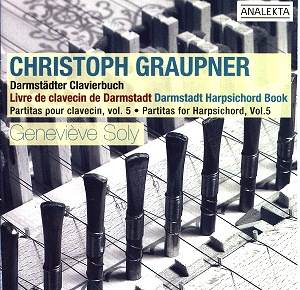Until recently Graupner
was little more than a name in books
of musical history. Even then, he often
appeared only as a kind of footnote
to the life of J.S. Bach, as someone
who was offered, but didnít take, the
post of cantor of the Church of Saint
Thomas in Leipzig before Bach was appointed.
Only in relatively recent years have
we been able to hear much of Graupnerís
music, and to realise the considerable
quality of much of it.
Twentieth century musical
scholarship had a little to say about
Graupner from time to time, but much
of his music remained unperformed Ė
and largely unstudied Ė in a library
in Darmstadt, where he worked from 1711
until his death. The revival in Graupnerís
fortunes, the very fact that his music
is being heard more often, has had much
to do with the efforts of the Canadian
musicologist and harpsichordist Geneviève
Soly. As a soloist, and as leader of
the ensemble Les Idées heureuses,
she has given concerts of Graupnerís
music in North America and Europe. The
Canadian label Analekta has issued a
series of CDs of Graupnerís music, which
have included instrumental and vocal
pieces. The present CD is the fifth
to be devoted to Graupnerís music for
solo harpsichord.
Graupner wrote some
forty-one partitas for harpsichord,
of which only seven have appeared in
modern editions; not all of which are
very easily accessible. The shortest
of the partitas has four movements,
the longest fourteen. Graupnerís music
for the harpsichord was not composed
as part of his duties and it presumably
reflects his own tastes and interests,
perhaps his own personality, with a
directness not always to be found in
other areas of his work. There is a
love of the instrument and its traditions
which is evident everywhere in these
works; a fascinated, and highly accomplished,
exploration of the instrumentís possibilities.
There are brilliant virtuoso passages;
there are relatively simple dances;
there is music of delicacy and tenderness,
there is music in which the rhythms
are fierce and insistent.
Of the music played
here, the Partita in A minor is essentially
in the French style, with an allemande,
a courante, a sarabande and two minuets
which are all reflective, even melancholy
and mostly on the slow side. The effect
is one of great intimacy. The Partita
in E major is more sophisticated, more
preoccupied with complex harmonic effects.
To the dances of the Partita (allemande,
courante, sarabande and gigue) Soly
has added two movements (a minuet and
a gavotte) from another of Graupnerís
collections, his Monatliche Clavir
Früchte. They have a Ďgalanteí
quality which complements the relatively
serious pieces of the original Partita.
In the Partita in C major, Soly has
again added movements from the Monatliche
Clavir Früchte to an original
Partita. There is some impressive counterpoint
in the Praeludium, some delightful melodic
invention in the sarabande and four
variations on it and some passionate
declamation in the loure. The
dancing rhythms of the gavottes - which
come from the Monatliche Clavir Früchte
- are irresistibly infectious.
Throughout Soly is
a perfect advocate for this music. She
plays with respectful freedom and though
scholarly is never dry or dogmatic.
She obviously loves the music and gets
great pleasure from it Ė a sense of
sheer fun is never far away. Without
in any way going over the top, she employs
a variety of registrations, always aptly
and persuasively.
This is very enthusiastically
recommended to anyone who loves the
harpsichord music of the first half
of the eighteenth century. I dare say
that those who have already discovered
Solyís Graupner will not need much encouragement
to seek out this latest volume. Those
who havenít yet made the acquaintance
of Graupner and his excellent interpreter
will find this a good place to start.
Analekta complement Solyís vivid playing
with an excellent recorded sound, catching
beautifully the full range of her instrument,
made in 1998 by Hubbard and Broekman
and modelled on the work of one of the
most important harpsichord builders
of Graupnerís own times, Hieronymus
Albrecht Hass.
Glyn Pursglove


